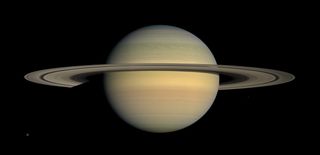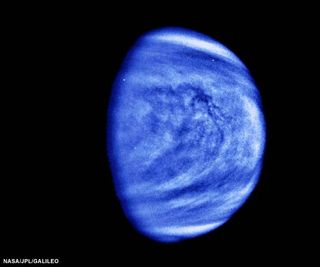
Even though their closest pairing came on the final day in June, Venus and Jupiter continue to be quite close together during the first several days of July.
Unfortunately, the two planets are also setting closer to the sun each evening, making it difficult for most observers to see them by month's end. As a consolation, both planets shift closer to the star Regulus, and on July 18, the trio will be joined by a lovely crescent moon.
Saturn is in the southern sky at nightfall this month; on July 25, the moon will sit to Saturn's upper right. Mercury is visible at dawn, low in the sky, until about mid-month, while Mars continues its "summer sabbatical," lingering much too close to the sun to be seen. [Skywatching in 2015: 9 Must-See Stargazing Events]
Below is a schedule that will help you view the planets of July's night sky. Remember that, when measuring the angular separation between two celestial objects, your clenched fist held at arm's length measures roughly 10 degrees.
July 1: Venus starts July with dimmer, distant Jupiter poised just 0.4 degrees to its upper right. Venus blazes 13 times more brightly than Jupiter. Hanging 8 degrees to their upper left is the bluish 1st-magnitude star Regulus, in the constellation Leo (the Lion), shining only 5 percent as brightly as Jupiter.
But the long Venus show of 2015 is ending. In early July, Venus and Jupiter still shine high and stay up until a little after dark, but each week, they sink lower and set earlier. And Jupiter appears to fall away from Venus.
Venus is by far the brightest starlike object in the sky as darkness falls. However, if you look to the sky at the same stage of twilight every night, you'll find that Venus is sinking quickly toward the horizon. Even though the planet is technically at its greatest brilliance on the evening of July 10, it becomes noticeably dimmer by then due to its low altitude. On July 7, Venus sets at the end of twilight; by month's end, it does so while the sky is still bright. In a telescope or even steadily held binoculars, Venus shows itself to be a bright little waning crescent.
Get the Space.com Newsletter
Breaking space news, the latest updates on rocket launches, skywatching events and more!
Jupiter sets 140 minutes after the sun as July begins. Even though the gas giant is the second-brightest evening "star," you may need binoculars to spot it by July 26 as it sinks into the glow of sunset. By month's end, Jupiter goes down less than an hour after the sun and is lost in the solar afterglow.

In the morning sky, Mercury is low and elusive, but the solar system's innermost planet shines brightly at magnitude minus 0.2 and is worth looking for. Start looking for it — if horizon haze is not too thick — very low in the east-northeast about an hour before sunrise. Try to follow Mercury for about another week (it brightens up by approximately 0.1 magnitude per day) as it sinks back into the solar glare and ultimately drops out of morning view.
July 18: About 45 minutes after sunset this evening, look low toward the western horizon for the thin (8-percent illuminated) crescent moon. Hovering about 1.3 degrees above it is Venus, while about 6 degrees to Venus' right is Jupiter. About 4 degrees above and slightly to the right of the moon shines Regulus in Leo, but you'll probably need binoculars to see the star against the bright twilight backdrop.
July 23: Mercury is in "superior conjunction," passing on the far side of the sun as it enters the evening sky.
July 25: As darkness falls, look almost due south for the waxing gibbous moon. That bright yellow-white "star" shining with a steady glow to the moon's lower left is Saturn. The famous ringed planet is gradually fading and slowly but surely backing into the sun's glare. Throughout this month, it is not too far from the star Antares in the constellation Scorpius. Saturn is the higher and brighter of the two objects, lying about 13 degrees to the star's upper right.
Joe Rao serves as an instructor and guest lecturer at New York's Hayden Planetarium. He writes about astronomy for Natural History magazine, the Farmer's Almanac and other publications, and he is also an on-camera meteorologist for News 12 Westchester, New York. Follow us @Spacedotcom, Facebook or Google+. Originally published on Space.com.
Join our Space Forums to keep talking space on the latest missions, night sky and more! And if you have a news tip, correction or comment, let us know at: community@space.com.

Joe Rao is Space.com's skywatching columnist, as well as a veteran meteorologist and eclipse chaser who also serves as an instructor and guest lecturer at New York's Hayden Planetarium. He writes about astronomy for Natural History magazine, the Farmers' Almanac and other publications. Joe is an 8-time Emmy-nominated meteorologist who served the Putnam Valley region of New York for over 21 years. You can find him on Twitter and YouTube tracking lunar and solar eclipses, meteor showers and more. To find out Joe's latest project, visit him on Twitter.
